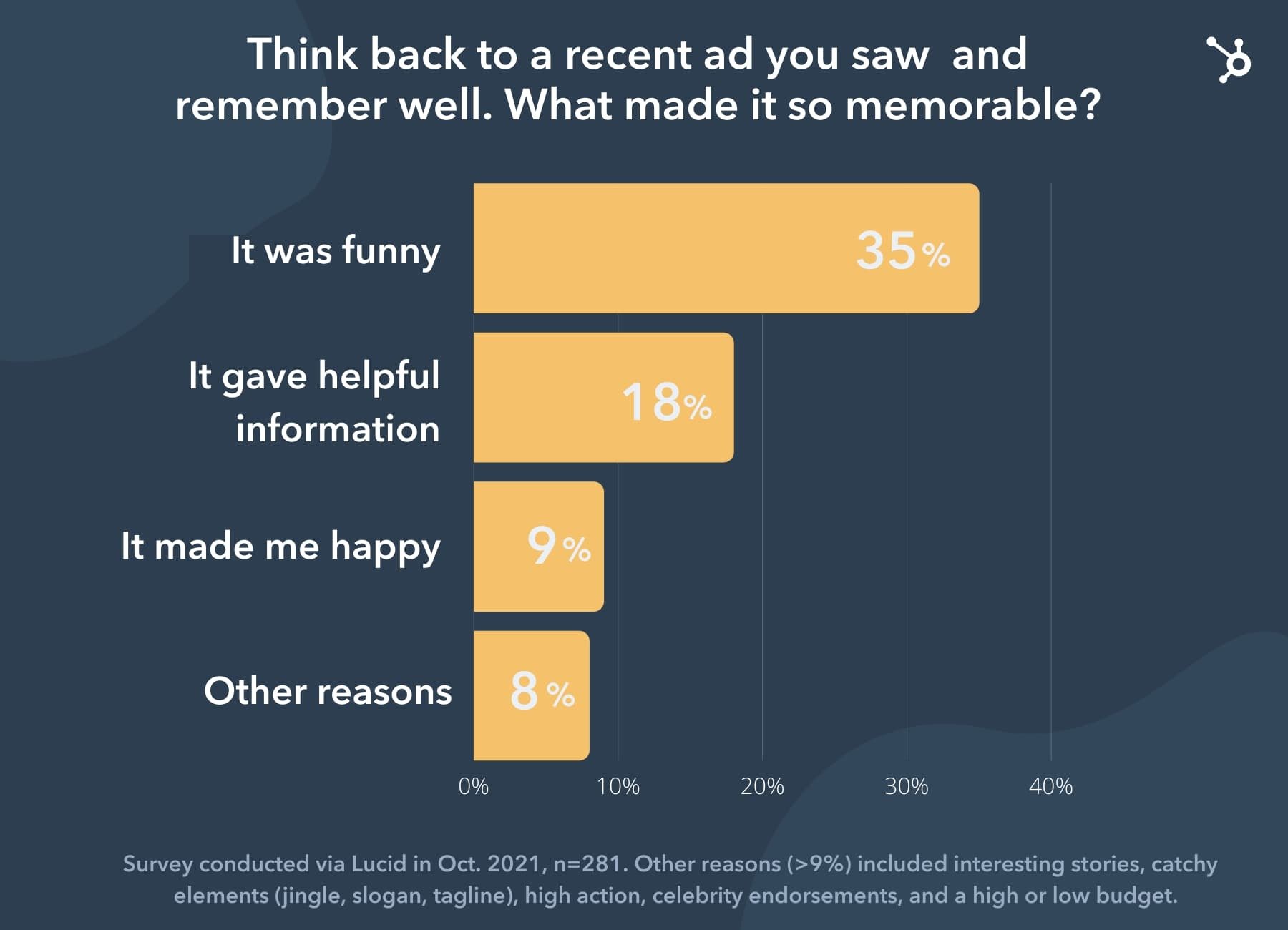Think about the last commercial you remember.
What about it made it memorable? That’s the answer every advertiser wants to know. I tend to remember ads that are funny and/or relatable, but is it the same for most consumers?
Let’s see what recent data suggests about memorable ads and discuss some tips for your next campaign.
Why Consumers Remember Ads
We surveyed 281 U.S. consumers and asked them to think back to a recent ad they saw and what made it memorable. Respondents could only select a single answer.
Here are the results.

Our research found that funny commercials were the number one reason why respondents recalled ads.
The second highest response was the value respondents ascribed to the information presented in the commercial.
The remaining options each made up less than 8% of the answers. Some remembered the ad because the product featured seemed valuable (7%), the ad told an interesting story (4%), or had a catchy element like a jingle or tagline (4%).
Additional reasons included:
- It featured interesting characters (3%)
- It was high action (3%)
- It made them sad (2%)
- It related to a topic I’m interested in (2%)
- it featured a celebrity or expert they knew (2%)
This survey also revealed that the least popular reason for ad recall was ad quality –meaning if it looked high budget (1%) or low budget (1%).
Insurance provider The General is a great example of how ads that are viewed as low budget can negatively affect brand perception.
CEO Tiku Raval revealed to AdWeek recently that the nature of its ads led consumers to believe they weren’t a reputable and credible company. Because of this, the brand recently overhauled its ad strategy with a fresh, new look.
The brand didn’t do this silently, they tackled the elephant in the room and addressed that misconception in its newest ads.
Now back to the research.
Eight percent of respondents said they remembered the ad for other reasons. One could be that the ad used fear, as that is a common tactic used in commercials. Particularly those that aim to change user habits or invite them to take action, like voting or smoking.
Now that we’ve gone through the results of the survey, let’s cover two of the most popular (and effective) devices used in advertising today and how they work to engage consumers.
The Use of Humor In Advertising
In my round-up of the top YouTube ads of the last two years, five out of nine ads that ranked were funny.
Our research revealed that ad recall was the strongest in ads that used humor. This supports research from a 2018 advertising survey by Clutch which showed that consumers prefer (and remember) ads that make them laugh.
Similarly, six out of nine ads that received an “A” grade in Kellogg’s 2021 School Super Bowl Advertising Review were humorous.
So, the question is why? Well, humor – when done right – brings people together through shared experiences. In fact, that’s what meme marketing is based on.
It allows people to forget their stresses.
The thing with humor is that you have to do it right. Otherwise, you risk facing a PR crisis.
Thinking back to 2020, at the height of the COVID-19 crisis, many brands halted ads and avoided humorous ads altogether, as many consumers found it inappropriate.
While the pandemic was extremely difficult to navigate, there were some moments of levity that could lend themselves well to advertisements.
Executive Creative Director Dave Hannenken from the advertising agency Hoffman York, wrote an article in which he highlighted some shared experiences we had during the pandemic. Working from home, baking banana bread, spending more time with kids and pets.
To get humor right, it’s all about finding a common ground and expanding upon it. Once you start zeroing in on something too unique and personal, that’s when you can land in the hot seat.
The Use of Education in Advertising
At the beginning of the buyer’s journey, consumers aren’t aware of the solutions to their problems. They may be aware of the challenges they face, but that may also be further down in the journey.
What we do know is that education can be an effective tool in building trust with your target audience and helping them move down the funnel.
Data from a 2018 Clutch advertising survey revealed that consumers want ads to teach them something. Fifty-one percent of respondents said they disliked an ad because it was uninformative.
Viewers want to leave an ad knowing about the product, the brand, and even the industry.
Education-driven ads can work particularly well for sustainability-conscious brands who share facts about the environment in their ads and explain what their company is doing to address it.
They appeal to consumers who value social responsibility and make purchasing decisions based on that – which is about 46% of consumers, according to a 2019 report.
Education can also be effective in ads that aim to promote an action or change a behavior.
While humor is a great way to grab their attention, it’s not the only way to captivate an audience. Creating compelling and memorable ads requires knowing your audience, understanding their challenges, and finding common ground that will resonate with them.
![]()


